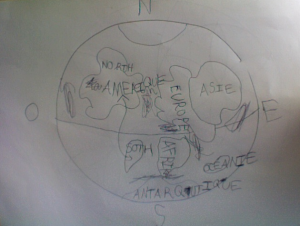My seven year old is studying geography. She endeavored, recently, to draw a map of the world with continents, poles, the equator and compass directions. The result? If you can accept each continent as an amoeba-like lump, she nailed it. Europe, as we live in France, is placed in the middle. Then, as I named them, she scribbled in the locations of the oceans. In the end, it was a fair representation from a single point of view, of the earth we live on.
We humans, of all sizes, learn new processes linearly. A new system gets committed to memory by going from point A to B to C; from the beginning to the end. Or in the case of the earth, from Europe out.
The same is true of your sales meeting. Ideally you have a standard template. In a first meeting with a prospective client, you have a list of items you want to communicate. For example, for your Friday meeting in Sacramento you want to offer four points, 1) A novel strategy that is highly relevant in today’s business climate, 2) One strength of your company that differentiates you in the marketplace, 3) Your experience working with companies in the state of California and the regulations relevant there, and 4) You’ll want to inform them about the new ‘trigger revolver’ nuance, a twist you’ve added to your product for two of your clients. In fact, you even mocked up a transaction for them with the trigger revolver in it, so they could see how it would help them and what the risks might be.
The point is you probably have a list of things you want to transmit and an order in your head, or your notebook, for how you might do this. Add to this your standard list of questions, plus questions your client research inspired, and the linear process for your meeting starts to take shape.
And you can follow that thread in a straight line fashion. You can make a presentation covering the key points, and then move to asking the questions you prepared.
Understanding the static (or 2D) representation is the first step in learning. Once that awareness is fully integrated into our knowledge base, we can then use it in a non-linear (or 3D) fashion. We diagnose what we need and we engage from the perspective that will provide the best tool to moving us forward. 
Our small geography student took the next important step. She told me that on her map the back side of the page was the Pacific Ocean. Then she rolled up the map, and showed me how the earth was spinning around its axis, and at the same time circling the sun. She got that the 2D representation was just a tool to represent a dynamic system. She got that you can start anywhere and build a representation of the earth from any perspective, if you know how the pieces fit.
It’s the same with your sales meeting plan. You could just start a dialog with the person sitting in front of you. You could just ask your client what they want to talk about, or ask one question to get started and see where the conversation takes you. When the questions and points you prepared are relevant to the conversation, you make sure that point gets covered. When the ‘trigger revolver’ comes up, you pull the mock transaction out of your back pocket. The art of conversation suggests that the information you impart is relevant to the current topic. The first hurdle is knowing what to say, the second is feeling when to say it. Waiting until the mock transaction is relevant and then showing it is a lot more powerful than saying at the meeting start that you have this thing prepared that you want to go over.
So plan, plan your meeting. Know the line you would follow. And, then go and let a conversation break out, and let the line re-order itself. The best meetings with prospects are nourishing conversations that don’t feel linear and planned, they feel natural, because they are. Because you planned it that way.
Tags: client meetings, conversation, planning a sales meeting
Great stuff!! i think it was Churchill who said something like, “in times of chaos, plans are useless, but the act of planning is invaluable.” You articulated this very well. Know your plan, and then rather than trying to be compelling by running your plan, follow that other old chestnut, “to be interesting, be interested.” And then drop in your planned information when you know the prospect is ready for it.